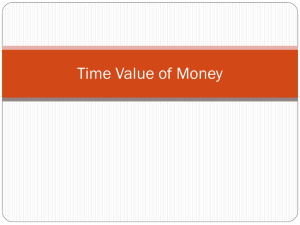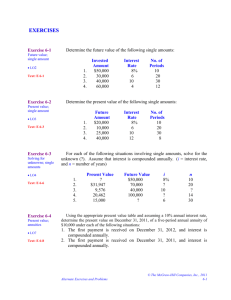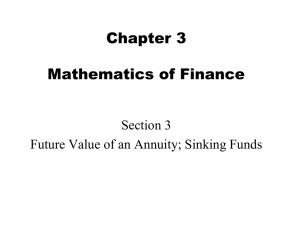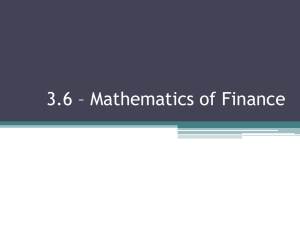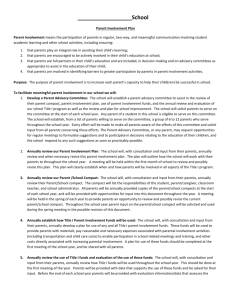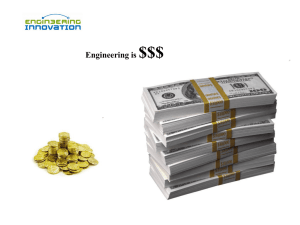Ch 13 Notes for the TI-84 or TI
advertisement
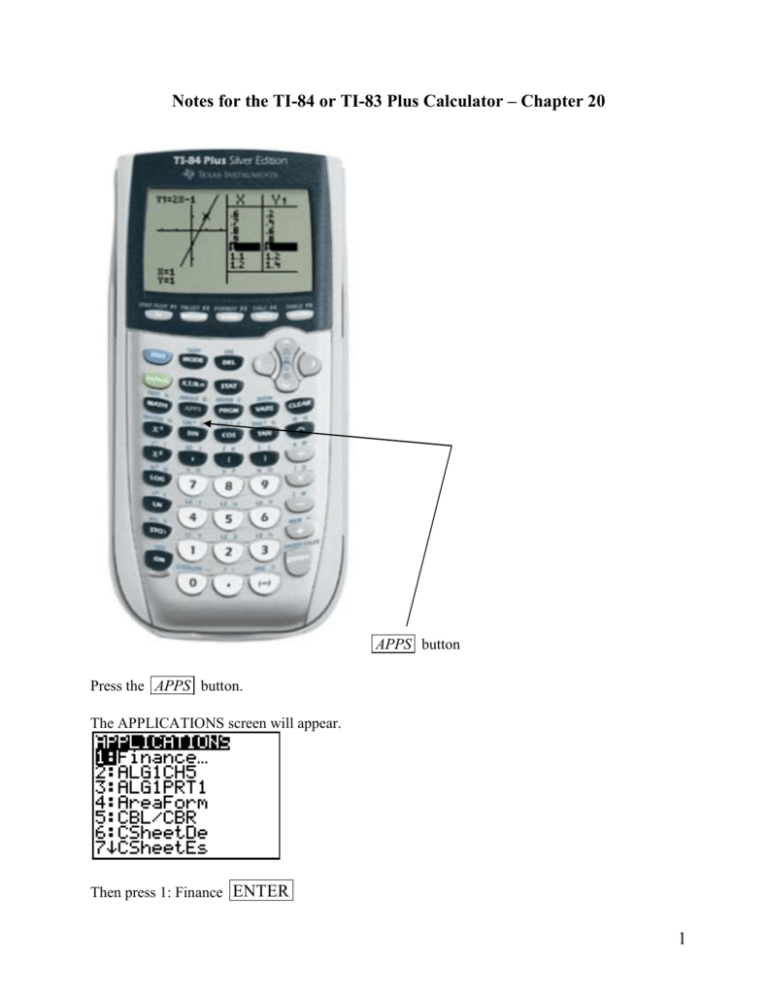
Notes for the TI-84 or TI-83 Plus Calculator – Chapter 20 APPS button Press the APPS button. The APPLICATIONS screen will appear. Then press 1: Finance ENTER 1 The screen should appear as follows: Press 1: TVM Solver. The screen display is : N is the total number of periods. I% is the interest rate given in the problem. PV is the present value of the annuity or sinking fund. PMT is the amount to be deposited or paid each period. FV is the future value of the annuity or sinking fund. P/Y is periods per year. C/Y is compounding per year. For PMT: [END] BEGIN leave, END darkened. If an annuity is compounded quarterly for 5 years, N will be 5*4=20 and P/Y and C/Y will each be 4 for quarterly. Enter the values for each. When the value is unknown, enter 0 for the value. Move the cursor to the value to be solved for. Press ALPHA ENTER to find the unknown value. The [SOLVE] key is the same key as the [ENTER] key. 2 Section 20.1 Examples 1. Ordinary Annuity Find the value of an investment after 3 years for a $3,000 ordinary annuity at 8%. Press the APPS button. The APPLICATIONS screen will appear. Press 1: Finance The screen should appear as follows: Press 1: TVM Solver. The screen should now look like: The correct values are: N=3 (compound annually for 3 years = 3 *1) I%=8 PV=0 (beginning balance) PMT= -3000 (enter the payment amount as a negative) FV=0 P/Y=1 (compound annually) C/Y=1 (compound annually) Move cursor to FV and press ALPHA ENTER . The calculator should now show: 3 Note a black square will appear to the left of the value that is solved for (FV). The value of an investment after 3 years for a $3,000 ordinary annuity at 8% is $9,739.20. 2. Annuity due-the money is deposited at the beginning. Find the value of an investment after 3 years for a $3,000 annuity due at 8%. Press the APPS button. The APPLICATIONS screen will appear. Press 1: Finance The screen should appear as follows: Press 1: TVM Solver. The screen should now look like: The correct values are: 4 N= # of periods plus one. N=4 (3 yrs compounded annually +1) I%=8 PV=0 (beginning balance) PMT= -3000 (enter the payment amount as a negative) FV=0 P/Y=1 (compound annually) C/Y=1 (compound annually) Move cursor to FV value, press ALPHA ENTER . The calculator should now show: Then subtract 1 payment. $13,518.34 -3,000.00 $10,518.34 Answer: $10,518.34 3. Example for non-annual payments Find the value of a $3,000 investment after 3 years made quarterly at 8%. a. For Ordinary Annuity Press the APPS button. The APPLICATIONS screen will appear. Press 1: Finance 5 The screen should appear as follows: Press 1: TVM Solver. The screen should now look like: The correct values are: N=12 (3 years compounded quarterly = 3 * 4) I%=8 PV=0 (beginning balance) PMT= -3000 (enter the payment amount as a negative) FV=0 P/Y=4 (compounded quarterly) C/Y=4 (compounded quarterly) Move cursor to FV and press ALPHA ENTER . The calculator should now show: Answer: $40,236.27 6 b. For annuity due be sure to add one period, solve, and then subtract one payment from the total. Press the APPS button. The APPLICATIONS screen will appear. Press 1: Finance The screen should appear as follows: Press 1: TVM Solver. The screen should now look like: The correct values are: N=13 (3 years compounded quarterly = 3 * 4 + 1 period for annuity due) I%=8 PV=0 (beginning balance) PMT= -3000 (enter the payment as a negative) FV=0 P/Y=4 quarterly C/Y=4 quarterly Move cursor to FV and press ALPHA ENTER . The calculator should now show: Now subtract one payment. 7 $44,040.99 -3,000.00 $41,040.99 Answer: $41,040.99 Practice. Answer each of the following. Fill in the values for the calculator screen. 1. a. Use the TI-84 or TI-83 to find the value of an investment after 4 years on an ordinary annuity of $4,000 made semi annually at 10%. N= I%= PV= PMT= FV= P/Y= C/Y= b. Recalculate as an annuity due. N= I%= PV= PMT= FV= P/Y= C/Y= 2. Wally Beaver won a lottery and will receive a check for $4000 at the beginning of each 6 months for the next 5 years. If Wally deposits each check into an account that pays 6%, how much will he have at the end of the 5 years? N= I%= PV= PMT= FV= P/Y= C/Y= 8 Answers to Practice 1. a. Use the TI-84 or TI-83 to find the value of an investment after 4 years on an ordinary annuity of $4,000 made semi annually at 10%. b. Recalculate as an annuity due. Solution: 1.a) Press the APPS button. The APPLICATIONS screen will appear. Press 1: Finance The screen should appear as follows: Press 1: TVM Solver. The screen should now look like: The correct values are: N=8 ( 4 years * 2 for semi-annually) I%=10 PV=0 (beginning balance) PMT= -4000 (enter the payment as a negative) FV=0 P/Y=2 (semi annually) C/Y=2 (semi annually) Move the cursor to FV and press ALPHA ENTER . 9 Answer: $38,196.44 b) For an annuity due be sure to add one period and subtract one payment from the total after solving. Press the APPS button. The APPLICATIONS screen will appear. Press 1: Finance The screen should appear as follows: Press 1: TVM Solver. The screen should now look like: The correct values are: N=9 (4 years * 2 for semi-annually +1 period for annuity) I%=10 PV=0 PMT=-4000 (enter the payment as a negative) FV=0 P/Y=2 (semi-annually) C/Y=2 (semi-annually) Move cursor to FV and press ALPHA ENTER . 10 Now subtract one payment. $44,106.26 -4000.00 $40,106.26 Answer: $40,106.26 2. Wally Beaver won a lottery and will receive a check for $4000 at the beginning of each 6 months for the next 5 years. If Wally deposits each check into an account that pays 6%, how much will he have at the end of the 5 years? Solution: This is an annuity due. Add 1 to the total number of periods. N=11 (5 years * 2 for semi annually + 1 period for annuity due) I%=6 PV=0 PMT= -4000 (enter the payment as a negative) FV=0 P/Y=2 (semi annually) C/Y=2 (semi annually) Move cursor to FV and press ALPHA ENTER . Now subtract 1 payment. $51,231.18 -4,000.00 $47,231.18 11 Answer: $47,231.18 Section 20.2 Examples 1. John Fitch wants to receive an $8,000 annuity over a three year period of time. Interest on the annuity is 8% annually. John will make withdrawals at the end of each year. How much must John invest today to receive a stream of payments for the next three years? Use the TI-84 or TI-83 calculator. Press the APPS button. The APPLICATIONS screen will appear. Press 1: Finance The screen should appear as follows: Press 1: TVM Solver. The screen should now look like: The correct values are: N=3 (3 years * 1 for annually) I%=8 PV=0 (beginning balance) PMT= -8000 (Withdrawal amount for each year.) FV= 0 (After he withdraws all the money, the balance will be zero) P/Y=1 C/Y=1 Since we want to know how much he must put in today, we are looking for PV. Move cursor to PV and press ALPHA ENTER . 12 Notice the black square to the left of PV. Answer: $20,616.78 2. Example using Ch 19 and Ch 20 material. John Sands made deposits of $200 semi annually to City Bank, which pays 8% interest compounded semi annually. After 5 years, John makes no more deposits. What will be the balance in the account 6 years after the last deposit? Solution: First use Ch 20 methods to compute balance at the end of 5 years. Press the APPS button. The APPLICATIONS screen will appear. Press 1: Finance The screen should appear as follows: Press 1: TVM Solver. The screen should now look like: 13 The correct values are: N=10 (5 years * 2 for semi-annually) I%=8 PV=0 PMT=-200 (deposit made each period) FV=0 P/Y=2 (semi annually) C/Y=2 (semi annually) Move cursor to FV and press ALPHA ENTER . FV = $2,401.22, so at the end of 5 years John has $2,401.22. Next, use Ch 19 methods to find out what he has six years later. The correct values are: N=12 (6 years * 2 for semi-annually) I%=8 PV=-2401.22 PMT=0 (no deposit made during this 6 years) FV=0 P/Y=2 C/Y=2 Move cursor to FV, press ALPHA ENTER . FV is $3,844.43. The value of the account at the end of the final 6 years is $3,844.43. 14 3. Mel Rich decided to retire in 8 years to New Mexico. What amount should Mel invest today so he will be able to withdraw $40,000 at the end of each year for 25 years after he retires? Assume Mel can invest money at 5% interest (compounded annually). Solution: First use Ch 20 methods to calculate the PV of the annuity. Press the APPS button. The APPLICATIONS screen will appear. Press 1: Finance The screen should appear as follows: Press 1: TVM Solver. The screen should now look like: The correct values are: N=25 (25 years * 1 for annually) I%=5 PV=0 PMT= -40000 (amount to be withdrawn each period) FV=0 (After 25 years, all has been withdrawn, balance is 0.) P/Y=1 (annually) C/Y=1 (annually) Move the cursor to PV and press ALPHA ENTER . 15 Mel will need $563,757.78 in 8 years in order to start withdrawing $ 40,000 per year for 25 years. But since Mel is now going to retire for 8 years, use Ch 19 methods to calculate how much Mel must deposit today in order to have $563,767.78 in 8 years. Press the APPS button. The APPLICATIONS screen will appear. Press 1: Finance The screen should appear as follows: Press 1: TVM Solver. The screen should now look like: The correct values are: N=8 (8 years * 1 for annually) I%=5 PV=0 PMT=0 (No deposits made during this time period.) FV=563757.78 (needed in 8 years) P/Y=1 (annually) C/Y=1 (annually) 16 Now move cursor to PV and press ALPHA ENTER . If Mel deposits $381,573.46 now, he will have $ 563,757.78 in eight years. Then, he can withdraw $40,000.00 per year for 25 years. Practice. Answer each of the following. Fill in the values for the calculator screen. 1. What must you invest today to receive an $18,000 annuity for 5 years semi annually at 10% annual rate? All withdrawals will be made at the end of each period. N= I%= PV= PMT= FV= P/Y= C/Y= 2. Rose High School wants to set up a scholarship fund to provide five $2,000 scholarships for the next 10 years. If money can be invested at an annual rate of 9%, how much should the scholarship committee invest today? N= I%= PV= PMT= FV= P/Y= C/Y= 17 3. Joe Wood decided to retire in 5 years in Arizona. What amount should Joe invest today so he can withdraw $60,000 at the end of each year for 30 years after he retires? Assume Joe can invest money at 6% compounded annually. N= I%= PV= PMT= FV= P/Y= C/Y= Answers to Practice. 1. What must you invest today to receive an $18,000 annuity for 5 years semi annually at 10% annual rate? All withdrawals will be made at the end of each period. Press the APPS button. The APPLICATIONS screen will appear. Press 1: Finance The screen should appear as follows: Press 1: TVM Solver. The screen should now look like: The correct values are: N=10 (5 years * 2 for semi annually) I%=10 PV=0 PMT= -18000 FV=0 (value of annuity will be zero after all withdrawals) P/Y=2 (for semi annually) C/Y=2 (for semi annually) 18 Move cursor to PV and press ALPHA ENTER . Answer: You need to invest $138,991.23 today in order to receive $18,000 for 5 years semi annually. 2. Rose High School wants to set up a scholarship fund to provide five $2000 scholarships for the next 10 years. If money can be invested at an annual rate of 9%, how much should the scholarship committee invest today? Press the APPS button. The APPLICATIONS screen will appear. Press 1: Finance The screen should appear as follows: Press 1: TVM Solver. The screen should now look like: 19 The correct values are: N=10 (10 years * 1 for annually) I%=9 PV=0 PMT= -10000 (5 scholarships at $2000 each) FV=0 (balance will be zero at the end of ten years) P/Y=1 (annually) C/Y=1 (annually) Move cursor to PV and press ALPHA ENTER . The scholarship committee should invest $64,176.58 today in order to provide the scholarships for the next ten years. 3. Joe Wood decided to retire in 5 years in Arizona. What amount should Joe invest today so he can withdraw $60,000 at the end of each year for 30 years after he retires? Assume Joe can invest money at 6% compounded annually. Press the APPS button. The APPLICATIONS screen will appear. Press 1: Finance The screen should appear as follows: Press 1: TVM Solver. 20 The screen should now look like: The correct values are: N=30 (30 years * 1 for annually) I%=6 PV=0 PMT= -60000 (amount of each withdrawal) FV=0 (balance at the end of 30 years) P/Y=1 (annually) C/Y=1 (annually) Move cursor to PV and press ALPHA ENTER . He needs $825,889.87 in 5 years so he can start withdrawing money every year. But, he wants to invest the money now and let it earn interest for 5 years until he retires. Press the APPS button. The APPLICATIONS screen will appear. Press 1: Finance The screen should appear as follows: 21 Press 1: TVM Solver. The screen should now look like: The correct values are: N=5 I%=6 PV= 0 PMT=0 FV=825889.87 P/Y=1 C/Y=1 Move cursor to PV and press ALPHA ENTER . Note: The present value shows up as a negative value. This is due to a required sign change. The amount needed to deposit today is $617,152.96. 22 Section 20.3 Examples To retire a bond issue, Moore Company needs $60,000 in 18 years from today. The interest rate is 10% compounded annually. What payment must Moore make at the end of each year? Solution: We need to solve for the payment amount. Press the APPS button. The APPLICATIONS screen will appear. Press 1: Finance The screen should appear as follows: Press 1: TVM Solver. The screen should now look like: The correct values are: N=18 (18 years * 1 for annually) I%=10 PV=0 (value at the beginning) PMT=0 FV=60000 P/Y=1 (annually) C/Y=1 (annually) Move cursor to PMT and press ALPHA ENTER . 23 Note: The payment amount is displayed as a negative value. This states that if Moore Company deposits $1,315.81 each period for 18 years, then $60,000 will be available to pay off the bond issue at maturity. Practice Problems 1. Today, Arrow Company issued bonds that will mature to a value of $90,000 in 10 years. Arrow’s controller is planning to set up a sinking fund. Interest rates are 12% compounded semi annually. What will Arrow Company have to set aside to meet its obligation in 10 years? Solution: N= I%= PV= PMT= FV= P/Y= C/Y= Answers to Practice 1. Today, Arrow Company issued bonds that will mature to a value of $90,000 in 10 years. Arrow’s controller is planning to set up a sinking fund. Interest rates are 12% compounded semi annually. What will Arrow Company have to set aside to meet its obligation in 10 years? Press the APPS button. 24 The APPLICATIONS screen will appear. Press 1: Finance The screen should appear as follows: Press 1: TVM Solver. The screen should now look like: The correct values are: N=20 (10 years * 2 for compounded semi annually) I%=12 PV=0 (value at the beginning) PMT=0 FV=90000 (amount needed) P/Y=2 (semi annually) C/Y=2 (semi annually) Move cursor to PMT and press ALPHA ENTER . Note: The payment amount is displayed as a negative number. This states that if Arrow Company deposits $ 2446.61 each period for 10 years, then $90,000 will be available to pay off the bond issue at maturity. 25

